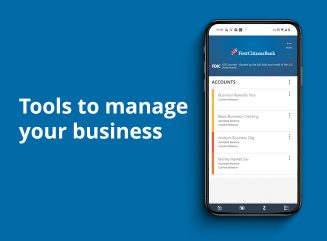Digital banking for business
Seamlessly access all of your accounts from one place with First Citizens Digital Banking for business.

Invest how you want, when you want, in real time with Self-Directed Investing.

Seamlessly access all of your accounts from one place with First Citizens Digital Banking for business.
We're committed to serving companies as they expand and succeed. The proof is in our success stories.
2026 Market Outlook video: Available now
The Making Sense team reflects on 2025 and discusses key headwinds and tailwinds for 2026.
Understanding the importance of supply chain management requires an awareness of the full scope of this concept and how it can impact business operations. Often, the terms supply chain management and logistics management are used interchangeably, but they're actually different concepts.

While logistics management refers to how companies handle any set of complex operations, supply chain management deals specifically with optimizing the flow of goods and services. This function includes the physical flow of materials involved in producing a good or service, developing, sourcing and manufacturing. It also involves information flow, ensuring access to the data required to make these activities happen in a timely, systematic manner.
Success is the ultimate goal in business. Supply chain management helps companies stay competitive by optimizing what their products and services are worth to the customer compared to competitors' alternatives. Consider the impact supply chain management has on business operations and your bottom line.
Supply chain management in an era of increased globalization and complexity goes beyond knowing exactly how to locate a shipment. Decision-makers will need end-to-end visibility across the chain. Here are some best practices to help.
Companies that can't see and manage what's going on in the global supply chain are vulnerable to competitors that can. Your goal should be an end-to-end view of the whole chain. Utilizing meaningful and timely metrics is essential to understanding supply chain performance. These can include information about orders, inventory pricing and cycle time. Calculate your business inventory requirements to stay ahead of disruptions.
Assess operations for opportunities to eliminate overproduction, disruptions and errors. Overproduction increases costs for storage and exposes the firm to risk of price or demand fluctuations. Hold-ups and defects can waste resources, as well as frustrate customers.
Sometimes a supply chain will contain fragmented or siloed information, such as manual processes—maybe a spreadsheet that only one or two people know how to maintain. Silos can be internal or external. If key decision-makers can't see siloed data, they can't plan for threats to the process or identify opportunities for growth. Take time to evaluate how stakeholders (internal and external) throughout the chain perform their roles to see what data can be targeted for visibility. Work with external partners, cultivating trust and transparency whenever possible. Then digitize any manual processes so that decision-makers can have the data at their fingertips.
Manufacturing can generate a river of paper documents, across vendors and even national borders. These documents need to be tracked and readied for prompt inspection. The faster agencies can authenticate the documents, the faster goods move. Inefficiency can arise when documents are misplaced or unable to be authenticated, increasing costs and waste. Invest in systems that protect the validity of your audit trail. For example, blockchain technology can make verifying transactions faster and more accurate by providing a secure digital ledger for all interactions between two parties.
All of these best practices are data-driven. Tracking, workflow management and streamlining processes require timely capture and access to meaningful information. You can get real-time decision-making power by starting with the relevant data, using software appropriate for your industry.
Respecting the importance of supply chain management to the company's specific and unique goals can become part of a company's culture. Seek to develop internal awareness for efficient and smart operations. Your bottom line depends on the results.



This material is for informational purposes only and is not intended to be an offer, specific investment strategy, recommendation or solicitation to purchase or sell any security or insurance product, and should not be construed as legal, tax or accounting advice. Please consult with your legal or tax advisor regarding the particular facts and circumstances of your situation prior to making any financial decision. While we believe that the information presented is from reliable sources, we do not represent, warrant or guarantee that it is accurate or complete.
Third parties mentioned are not affiliated with First-Citizens Bank & Trust Company.
Links to third-party websites may have a privacy policy different from First Citizens Bank and may provide less security than this website. First Citizens Bank and its affiliates are not responsible for the products, services and content on any third-party website.
First Citizens Bank is a Member FDIC and an Equal Housing Lender icon: sys-ehl.
NMLSR ID 503941

Treasury & Cash Management
Electronic Bill Presentment & Payment
Investment & Retirement Services
Community Association Banking
Equipment Financing & Leasing
Credit Cards
Merchant Services
Email Us
Please select the option that best matches your needs.
Customers with account-related questions who aren't enrolled in Digital Banking or who would prefer to talk with someone can call us directly.